"sandbox:Bagheri"
cranial nerve I (olfactory nerve)
|
WikiDoc Resources for "sandbox:Bagheri" |
|
Articles |
|---|
|
Most recent articles on "sandbox:Bagheri" Most cited articles on "sandbox:Bagheri" |
|
Media |
|
Powerpoint slides on "sandbox:Bagheri" |
|
Evidence Based Medicine |
|
Cochrane Collaboration on "sandbox:Bagheri" |
|
Clinical Trials |
|
Ongoing Trials on "sandbox:Bagheri" at Clinical Trials.gov Trial results on "sandbox:Bagheri" Clinical Trials on "sandbox:Bagheri" at Google
|
|
Guidelines / Policies / Govt |
|
US National Guidelines Clearinghouse on "sandbox:Bagheri" NICE Guidance on "sandbox:Bagheri"
|
|
Books |
|
News |
|
Commentary |
|
Definitions |
|
Patient Resources / Community |
|
Patient resources on "sandbox:Bagheri" Discussion groups on "sandbox:Bagheri" Patient Handouts on "sandbox:Bagheri" Directions to Hospitals Treating "sandbox:Bagheri" Risk calculators and risk factors for "sandbox:Bagheri"
|
|
Healthcare Provider Resources |
|
Causes & Risk Factors for "sandbox:Bagheri" |
|
Continuing Medical Education (CME) |
|
International |
|
|
|
Business |
|
Experimental / Informatics |
Editor-In-Chief: C. Michael Gibson, M.S., M.D. [1]
Synonyms and Keywords: Cranial Nerve I,
Overview
The first of twelve cranial nerves is olfactory nerve or CN I.
The olfactory nerve or CN I, is the first of twelve cranial nerves that contains sensory nerve fibers relating to the sense of smell. The specialized olfactory receptor neurons of the olfactory nerve are located in the olfactory mucosa of the upper parts of the nasal cavity. The olfactory nerve consists of a collection of sensory nerve fibers that extend from the olfactory epithelium to the olfactory bulb, passing through the many openings of the cribriform plate, a sieve-like structure.
Olfactory receptor neurons continue to be born throughout life and extend new axons to the olfactory bulb. Olfactory ensheathing glia wrap bundles of these axons and are thought to facilitate their passage into the central nervous system.
The sense of smell (olfaction) arises from the stimulation of the olfactory receptors by activation from gas molecules that pass by the nose during respiration. The resulting electrical activity is transduced into the olfactory bulb which then transmits the electrical activity to other parts of the olfactory system and the rest of the central nervous system via the olfactory tract.
The olfactory nerve is the shortest of all the twelve cranial nerves and only one of two cranial nerves (the other being the optic nerve) that do not join with the brainstem.
Historical Perspective
- Discovery of cranial nerves started in the 2nd century by Galen, but these 12 cranial nerves that we recognize today was enumerated by Samuel Sömmerring in 1778.[1]
Function
The afferent nerve fibers of the olfactory receptor neurons transmit nerve impulses about odors to the central nervous system, where they are perceived as smell (olfaction).
The olfactory nerve is special visceral afferent (SVA).
Diseases
Many diseases can involve olfactory nerve and some of them can cause transient or permanent damage to this cranial nerve and lead to anosmia, like :
- Allergies
- Common cold
- Infection
- Nasal polyp
- Old age
- Sinusitis
- Stuffy nose
- Trauma
Testing the Olfactory nerve
Damage to this nerve leads to impairment or total loss anosmia of the sense of smell To simply test the function of the olfactory nerve, each nostril is tested with a pungent odor. If the odor is smelled, the olfactory nerve is likely functioning. On the other hand, the nerve is only one of several reasons that could explain if the odor is not smelled. There are olfactory testing packets in which strong odors are embedded into cards and the responses of the patient to each odor can be determined.Vilensky, Joel (2015). The clinical anatomy of the cranial nerves : the nerves of an old Olympus towering top. Ames, Iowa: Wiley Blackwell. ISBN 978-1118492017.
Imaging
Olfactory bulbs can spot on coronal T1 weighted MRI.[2]
